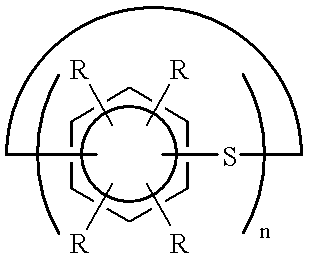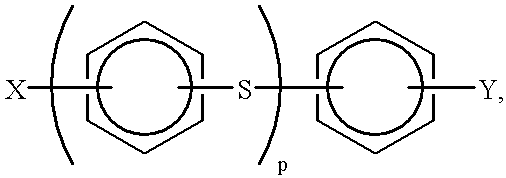Process for preparing poly(arylene sulfide) polymers using waste material
a technology of arylene sulfide and polymer, applied in the field of process for preparing a poly (arylene sulfide) polymer, can solve the problems of unacceptable original intended use, contamination of polymer products, etc., and achieve the effect of optimizing the economics of invention method operation, reducing molecular weight, and no effect on polymer properties
- Summary
- Abstract
- Description
- Claims
- Application Information
AI Technical Summary
Benefits of technology
Problems solved by technology
Method used
Image
Examples
example i
This example describes the general preparation of a poly(p-phenylene sulfide) polymer, (PPS), according to the method disclosed in U.S. Pat. No. 3,919,177, and the separation of crude polymerization product into a granular, higher molecular weight product and a finer particle sized, lower molecular weight product. In this typical PPS preparation, a mixture of aqueous sodium bisulfide (NaSH) (419.8 moles), 428.2 moles aqueous sodium hydroxide (NaOH), a portion of the total 1400 moles of N-methyl-2-pyrrolidone (NMP), and 127.3 moles aqueous sodium acetate (NaOAc) in a stirred reactor were heated and a portion of the water was removed in a dehydration step.
After the dehydration step, 426.4 moles p-dichlorobenzene (DCB) and remaining portion of the 1400 moles of NMP were added to the dehydrated mixture and the total mixture was heated to polymerization conditions (265.6.degree. C.) to produce PPS. At the conclusion of the polymerization, the reactor was cooled to about 93.degree. C. to ...
example ii
This example describes the effect of adding PPS fines obtained from a PPS polymerization and recovery to-another PPS polymerization. Control PPS polymerization Run 1 was carried out in a one-liter, stirred autoclave. The autoclave was charged with 1.0 g-mol NaSH as an aqueous mixture containing 73.4 weight percent NaSH, 1.02 g-mol NaOH, and 2.00 g-mol NMP. After the autoclave had been flushed with nitrogen, the stirred autoclave was heated and dehydration was carried out.
Following dehydration, 1.03 g-mol of DCB and 1.00 g-mol NMP were charged to the dehydrated mixture and the reactor was heated to 235.degree. C. and held for one hour. The reactor was then heated to 265.degree. C. and held for two hours. Then, the reactor was cooled and opened. The product mixture was a gray dry appearing cake. The product was washed with distilled water 8 times at temperatures of 80-90.degree. C., then filtered to recover a polymer product. Approximately 106 g of PPS with an extrusion rate of 34.7 g...
example iii
Several PPS polymerization runs were carried out to demonstrate the effect of adding various levels of washed fines and the effect of adding fines at different times during the polymerization. Washed PPS fines B was prepared from another PPS crude filtrate using the same procedure as described in Example I. Washed PPS fines B had a Mw of 31,100 g / mol and had 37.9 weight percent between 100 and 10,000 g / mol. The GPC distribution of washed PPS fines B is shown in FIG. 1.
PPS polymerization Runs 3 and 4 were control runs without added fines. These runs were done in a manner similar to the procedure for Run 1 in Example II except for the use of three hours at 265.degree. C. instead of two hours. All polymerizations in these examples used three hours at 265.degree. C., except for Runs 1 and 2.
Invention Runs 5, 6, and 7 involved the addition of three different levels of washed PPS fines B immediately after the NMP-DCB charge. In Run 5, 1.01 g-mol of DCB in 0.75 g-mol NMP was charged to the...
PUM
| Property | Measurement | Unit |
|---|---|---|
| GPC molecular weight distributions | aaaaa | aaaaa |
| GPC molecular weight distributions | aaaaa | aaaaa |
| temperature | aaaaa | aaaaa |
Abstract
Description
Claims
Application Information
 Login to View More
Login to View More - R&D Engineer
- R&D Manager
- IP Professional
- Industry Leading Data Capabilities
- Powerful AI technology
- Patent DNA Extraction
Browse by: Latest US Patents, China's latest patents, Technical Efficacy Thesaurus, Application Domain, Technology Topic, Popular Technical Reports.
© 2024 PatSnap. All rights reserved.Legal|Privacy policy|Modern Slavery Act Transparency Statement|Sitemap|About US| Contact US: help@patsnap.com










